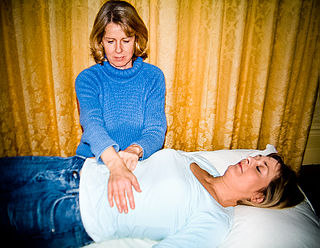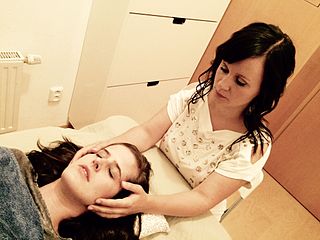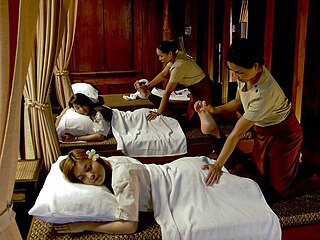
Acupressure is an alternative medicine technique often used in conjunction with acupuncture or reflexology. It is based on the concept of life energy (qi), which purportedly flows through "meridians" in the body. In treatment, physical pressure is applied to acupuncture points, or ashi trigger points, with the aim of clearing blockages in these meridians. Pressure may be applied by hand, by elbow, or with various devices. There is no scientific evidence for the existence of acupuncture points, meridians, or qi.

Massage is the rubbing or kneading of the body's soft tissues. Massage techniques are commonly applied with hands, fingers, elbows, knees, forearms, feet or a device. The purpose of massage is generally for the treatment of body stress or pain. In European countries, a person professionally trained to give massages is traditionally known as a masseur (male) or masseuse (female). In the United States, these individuals are often referred to as "massage therapists". In some provinces of Canada, they are called "registered massage therapists."

Reiki is a pseudoscientific form of energy healing, a type of alternative medicine originating in Japan. Reiki practitioners use a technique called palm healing or hands-on healing through which, according to practitioners, a "universal energy" is transferred through the palms of the practitioner to the client, to encourage emotional or physical healing. It is based on qi ("chi"), which practitioners say is a universal life force, although there is no empirical evidence that such a life force exists.
Rolfing is a form of alternative medicine originally developed by Ida Rolf (1896–1979) as Structural Integration. Rolfing is marketed with unproven claims of various health benefits. It is based on Rolf's ideas about how the human body's "energy field" can benefit when aligned with the Earth's gravitational field.

Reflexology, also known as zone therapy, is an alternative medical practice involving the application of pressure to specific points on the feet, ears, and hands. This is done using thumb, finger, and hand massage techniques without the use of oil or lotion. It is based on a system of zones and reflex areas that purportedly reflect an image of the body on the feet and hands, with the premise that such work on the feet and hands causes a physical change to the supposedly related areas of the body.

Craniosacral therapy (CST) or cranial osteopathy is a form of alternative medicine that uses gentle touch to feel non-existent rhythmic movements of the skull's bones and supposedly adjust the immovable joints of the skull to achieve a therapeutic result. CST is a pseudoscience and its practice has been characterized as quackery. It is based on fundamental misconceptions about the anatomy and physiology of the human skull and is promoted as a cure-all for a variety of health conditions.
The Hakomi Method is a form of mindfulness-centered somatic psychotherapy developed by Ron Kurtz in the 1970s.

Traditional Thai massage or Thai yoga massage is a traditional therapy combining acupressure, Indian Ayurvedic principles, and assisted yoga postures. In the Thai language, it is usually called nuat phaen thai or nuat phaen boran, though its formal name is nuat thai according to the Traditional Thai Medical Professions Act, BE 2556 (2013).
Manual therapy, or manipulative therapy, is a part of Physiotherapy, it is a physical treatment primarily used by physical therapists, occupational therapists to treat musculoskeletal pain and disability; it mostly includes kneading and manipulation of muscles, joint mobilization and joint manipulation. It is also used by Rolfers, massage therapists, athletic trainers, osteopaths, and physicians.
Hilot (/HEE-lot/) is an ancient Filipino art of healing. It uses manipulation and massage to achieve the treatment outcome, although techniques differ from one practitioner to another. It emerged from the shamanic tradition of the ancient Filipinos with healers considering their practice as derived from their calling from visions or from having been born by breech.
Lomilomi massage is a Polynesian method of kneading massage, but with overtones of the indigenous religious beliefs. The word lomilomi comes from the Hawaiian and Samoan languages. Lomi means "to knead.” The smooth flow of the strokes mimic the ocean waves. It may also mean "to take and turn, to shift" as in "the sacred shift within you that is inspired by the healing kahuna," spoken twice for emphasis.
Somatic Experiencing (SE) is a form of alternative therapy aimed at treating trauma and stress-related disorders, such as PTSD. The primary goal of SE is to modify the trauma-related stress response through bottom-up processing. The client's attention is directed toward internal sensations,, rather than to cognitive or emotional experiences. The method was developed by Peter A. Levine.

The stone massage is a form of alternative medicine massage therapy and bodywork involving the placement of either heated or cooled stones to the body for the purpose of pain relief, relaxation and therapy. There are many variations and techniques used in the application of stone massage therapy, deriving from a variety of traditional practices. Stone massages are primarily used to alleviate physical pain issues, however, are also used to promote emotional and spiritual wellbeing in practice.

Energy medicine is a branch of alternative medicine based on a pseudo-scientific belief that healers can channel "healing energy" into a patient and effect positive results. The field is defined by shared beliefs and practices relating to mysticism and esotericism in the wider alternative medicine sphere rather than any sort of unified terminology, leading to terms such as energy healing or vibrational medicine being used as synonymous or alternative names. In most cases there is no empirically measurable energy involved: the term refers instead to so-called subtle energy. Practitioners may classify the practice as hands-on, hands-off, and distant where the patient and healer are in different locations. Many schools of energy healing exist using many names: for example, biofield energy healing, spiritual healing, contact healing, distant healing, therapeutic touch, Reiki or Qigong.
A dental spa is a dental facility supervised by a licensed Oral Health Care Provider in which dental services are provided alongside spa treatments.
Rosen Method Bodywork is a type of Complementary and alternative medicine. This bodywork, described as 'psychosomatic', claims to help integrate one's bodily and emotional/mental experience. In the tradition of sensory awareness methods, Rosen Method Bodywork focuses clients' attention onto internal sensations and emotions that arise as areas for the body are gently contacted with a 'listening' touch. This means that the practitioner's goal is not to manipulate or fix clients but rather to notice areas of tension and stillness. The practitioner uses words to help clients become aware of these held places in the body and encourages clients to describe what they are feeling.
Zero balancing is a type of manual therapy devised by American osteopathic doctor Frederick "Fritz" Smith in the 1970s. Drawing from principles of osteopathy, Chinese medicine and Structural Integration, Smith proposed that the energy field within the human body could be affected by manual manipulations, thus bringing health benefits. The practice teaches that currents of energy are stored within the human skeleton, and that these affect both physical and mental wellbeing.
Chua K'a is a three-part bodywork approach developed by Oscar Ichazo. It is based on the observation that tension in the body corresponds to specific fears; therefore, removing the tension via bodywork can remove the psychological trauma, a concept similar to other Mind–body_interventions.

Somatics is a field within bodywork and movement studies which emphasizes internal physical perception and experience. The term is used in movement therapy to signify approaches based on the soma, or "the body as perceived from within", including Skinner Releasing Technique, Alexander technique, the Feldenkrais Method, Eutony, Rolfing Structural Integration, among others. In dance, the term refers to techniques based on the dancer's internal sensation, in contrast with "performative techniques", such as ballet or modern dance, which emphasize the external observation of movement by an audience. Somatic techniques may be used in bodywork, psychotherapy, dance, or spiritual practices.
Marion Rosen was a German-American physiotherapist. She developed Rosen Method Bodywork and Rosen Method Movement. Under Rosen's guidance in 1980, the Rosen Institute (RI) was formed as the governing international organization that protects and sustains the quality and standards of Rosen Method. The Rosen Institute has affiliate training centers in 16 countries and has certified 1150 bodywork practitioners and 150 movement teachers.








